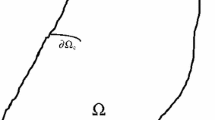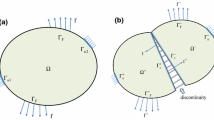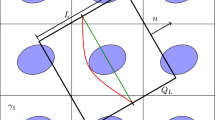Abstract
This paper presents a coupling technique for integrating the element-free Galerkin method (EFGM) with fractal the finite element method (FFEM) for analyzing homogeneous, anisotropic, and two dimensional linear-elastic cracked structures subjected to mixed-mode (modes I and II) loading conditions. FFEM is adopted for discretization of domain close to the crack tip and EFGM is adopted in the rest of the domain. In the transition region interface elements are employed. The shape functions within interface elements which comprises both the element-free Galerkin and the finite element shape functions, satisfies the consistency condition thus ensuring convergence of the proposed coupled EFGM-FFEM. The proposed method combines the best features of EFGM and FFEM, in the sense that no structured mesh or special enriched basis functions are necessary and no post-processing (employing any path independent integrals) is needed to determine fracture parameters such as stress-intensity factors (SIFs) and T − stress. The numerical results based on all four orthotropic cases show that SIFs and T − stress obtained using the proposed method are in excellent agreement with the reference solutions for the structural and crack geometries considered in the present study. Also a parametric study is carried out to examine the effects of the integration order, the similarity ratio, the number of transformation terms, and the crack length to width ratio on the quality of the numerical solutions.
Similar content being viewed by others
References
Aluru NR (2000) A point collocation method based on reproducing kernel approximations. Int J Numer Methods Eng 47: 1083–1121
Atluri SN, Zhu T (1998) A new meshless local Petrov–Galerkin (MLPG) approach in computational mechanics. Comput Mech 22: 117–127
Belytschko T, Lu YY, Gu L (1994) Element-free Galerkin methods. Int J Numer Methods Eng 37: 229–256
Belytschko T, Lu YY, Gu L (1995a) Crack propagation by element-free Galerkin methods. Eng Fract Mech 51: 295– 315
Belytschko T, Organ D, Krongauz Y (1995b) Coupled finite element–element-free Galerkin method. Comput Mech 17: 186–195
Belytschko T, Krongauz Y, Organ D, Fleming M, Krysl P (1996) Meshless methods: an overview and recent developments. Comput Methods Appl Mech Eng 139: 3–47
Bowie OL, Freese CE (1972) Central crack in plane orthotropic rectangular sheet. Int J Fract Mech 8(1): 49–57
Cardew GE, Goldthorpe MR, Howard IC, Kfouri AP (1984) On the elastic T-term. Fundamentals of deformation and fracture. In: Bilby BA, Miller KJ, Willis JR (eds) Cambridge University Press, Cambridge
Chen JS, Wang HP (2000) New boundary condition treatments in meshfree computation of contact problems. Comput Methods Appl Mech Eng 187(3–4): 441–468
Chen T, Raju IS (2003) A coupled finite element and meshless local Petrov–Galerkin method for two-dimensional potential problems. Comput Methods Appl Mech Eng 192: 4533–4550
Chu SJ, Hong CS (1990) Application of the J k integral to mixed mode crack problems for anisotropic composite laminates. Eng Fract Mech 35(6): 1093–1103
Cook RD, Malkus DS, Plesha ME (2001) Concepts and Applications of Finite Element Analysis. John Wiley and Sons, New York
Delale F, Erdogan F (1977) The problem on internal and edge cracks in an orthotropic strip. ASME J Appl Mech 44(2): 237–242
Duarte CAM, Oden JT (1996) H-p clouds—an h-p meshless method. Numer Methods Partial Differ Equ 12(6): 673–705
Fleming M, Chu YA, Moran B, Belytschko T, Lu YY, Gu L (1997) Enriched element-free Galerkin methods for crack-tip fields. Int J Numer Methods Eng 40: 1483–1504
Gu YT, Liu GR (2001) A coupled element free Galerkin/boundary element method for stress analysis of two-dimensional solids. Comput Methods Appl Mech Eng 190(34): 4405–4419
Hegen D (1996) Element-free Galerkin methods in combination with finite element approaches. Comput Methods Appl Mech Eng 135: 143–166
Hu CB, Li YT, Gong J (1998) The transition method of geometrically similar element for dynamic crack Problem. Key Eng Mater 145–149(Part 1): 267–272
Huerta A, Fernandez-Mendez S (2000) Enrichment and coupling of the finite element and meshless methods. Int J Numer Methods Eng 48: 1615–1636
Idelsohn SR, Oñate E, Calvo N, Pin FD (2003) The meshless finite element method. Int J Numer Methods Eng 58: 893–912
Kaya AC, Erdogan F (1980) Stress intensity factors and COD in an orthotropic strip. Int J Fract 16(2): 171–190
Krishnamurthy T, Raju IS (1993) Coupling finite and boundary element methods for two-dimensional potential problems. Int J Numer Methods Eng 36: 3593–3616
Krongauz Y, Belytschko T (1996) Enforcement of essential boundary conditions in meshless approximations using finite elements. Comput Methods Appl Mech Eng 131(1-2): 133–145
Lancaster P, Salkauskas K (1981) Surfaces generated by moving least sqaures methods. Math Comput 37: 141–158
Lekhnitskii SG (1963) Theory of elasticity of an anisotropic elastic body. Holden Day., Inc, San Francisco
Lekhnitskii SG, Tsai SW, Cheron T (1968) Anisotropic plates. Gordon and Breach Science Publishers, New York
Leung AYT, Su RKL (1994) Mode I crack problems by fractal two-level finite element methods. Eng Fract Mech 48(6): 847–856
Leung AYT, Su RKL (1995a) Mixed mode twodimensional crack problems by fractal two-level finite element method. Eng Fract Mech 51(6): 889–895
Leung AYT, Su RKL (1995b) A numerical study of singular stress field of 3-D cracks. Finite Elem Anal Des 18: 389–401
Leung AYT, Su RKL (1996a) Fractal two-level finite element method for cracked Kirchhoff’s plates using DKT elements. Eng Fract Mech 54(5): 703–711
Leung AYT, Su RKL (1996b) Applications of fractal two-level finite element method for 2D cracks. Microcomput Civ Eng 11(4): 249–257
Leung AYT, Su RKL (1996c) Fractal two-level finite element analysis of cracked reissner’s plate. Thin Walled Struct 24(4): 315–334
Leung AYT, Su RKL (1998a) Two-level finite element study of axisymmetric cracks. Int J Fract 89(2): 193–203
Leung AYT, Su RKL (1998b) Eigenfunction expansion for penny-shaped and circumferential cracks. Int J Fract 89(3): 205–222
Leung AYT, Su RKL (1998c) Fractal Two-Level Finite Element Method for Free Vibration of Cracked Beams. J Shock Vib 5(1): 61–68
Li S, Liu WK (2001) Meshfree and particle methods and their applications. Appl Mech Rev 55: 1–34
Liu WK, Jun S, Zhang YF (1995) Reproducing kernel particle methods. Int J Numer Methods Fluids 20: 1081–1106
Liu GR, Gu YT (2000a) Meshless local Petrov–Galerkin (MLPG) method in combination with finite element and boundary element approaches. Comput Mech 26: 536–546
Liu GR, Gu YT (2000b) Coupling of element free Galerkin and hybrid boundary element methods using modified variational formulation. Comput Mech 26: 166–173
Liu GR, Zhang GY, Dai KY (2005) A linearly conforming point interpolant method (LC-PIM) for 2d solid mechanics problems. Int J Comput Methods 2: 645–665
Lu YY, Belytschko T, Liu WK (1991) A variationally coupled FE-BE method for elasticity and fracture mechanics. Comput Methods Appl Mech Eng 85: 21–37
Lu YY, Belytschko T, Gu L (1994) New implementation of the element free Galerkin method. Comput Methods Appl Mech Eng 113: 397–414
Melenk JM, Babuska I (1996) The partition of unity finite element method: basic theory and applications. Comput Methods Appl Mech Eng 139: 280–314
Monaghan JJ (1992) Smoothed particle hydrodynamics. Annu Rev Astron Astrophys 30: 543–574
Nayroles B, Touzot G, Villon P (1992) Generalizing the finite element method: diffuse approximation and diffuse elements. Comput Mech 10: 307–318
Nguyen VP, Rabczuk T, Bordas S, Duflot M (2008) Meshless methods: A review and computer implementation aspects. Math Comput Simul 79: 763–813
Organ DJ, Fleming M, Terry T, Belytschko T (1996) Continuous meshless approximations for non-convex bodies by diffraction and transparency. Comput Mech 18: 225–235
Preparata FP, Shamos MI (1990) Computational geometry: an introduction. Springer, New York
Rao BN, Rahman S (2000) An efficient meshless method for fracture analysis of cracks. Comput Mech 26: 398–408
Rao BN, Rahman S (2001) A coupled meshless-finite element method for fracture analysis of cracks. Int J Press Vessel Pip 78: 647–657
Sedgewick R (1988) Algorithms. Addison-Wesley, Reading, MA
Singh IV (2004) A numerical solution of composite heat transfer problems using meshless method. Int J Heat Mass Transf 47: 2123–2138
Song CM, Wolf JP (2002) Semi-analytical representation of stress singularities as occurring in cracks in anisotropic multi-materials with the scaled boundary finite-element method. Comput Struct 80: 183–197
Su RKL, Leung AYT (2001a) Mixed mode cracks in reissner plates. Int J Fract 107(3): 235–257
Su RKL, Leung AYT (2001b) Three-dimensional mixed mode analysis of a cracked body by fractal finite element method. Int J Fract 110(1): 1–20
Su RKL, Sun HY (2002) Numerical solution of cracked Thin plates subjected to bending, twisting and shear loads. Int J Fract 117(4): 323–335
Su RKL, Sun HY (2003) Numerical Solutions of Two-Dimensional Anisotropic Crack Problems. Int J Solids Struct 40: 4615–4635
Su RKL, Sun HY (2005) A Brief Note on Elastic T−stress for Centred Crack in Anisotropic Plate. Int J Fract 131: 53–58
Sukumar N, Moran B, Belytschko T (1998) The natural element method in solid mechanics. Int J Numer Methods Eng 43: 839–887
Sun HY (2003) Fractal finite element method for anisotropic crack problems, M.Phil thesis. The University of Hong Kong
Wagner GJ, Liu WK (2001) Hierarchical enrichment for bridging scales and mesh-free boundary conditions. Int J Numer Methods Eng 50: 507–524
Williams ML (1957) On the stress distribution at the base of a stationary crack. ASME J Appl Mech 24: 109–114
Xie JF, Fok SL, Leung AYT (2003) A parametric study on the fractal finite element method for two-dimensional crack problems. Int J Numer Methods Eng 58: 631–642
Zhang GY, Liu GR, Wang YY, Huang HT, Zhong ZH, Li GY, Han X (2007) A linearly conforming point interpolation method (LC-PIM) for three-dimensional elasticity problems. Int J Numer Methods Eng 72: 1524–1543
Zhang LT, Wagner GJ, Liu WK (2002) A parallelized meshfree method with boundary enrichment for large-scale CFD. J Comput Phys 176: 483–506
Zhang X, Yao ZH, Zhang ZF (2006) Application of MLPG in large deformation analysis. Acta Mechanica Sinica 22: 331–340
Zhu T, Zhang JD, Atluri SN (1998) A local boundary integral equation (LBIE) method in computational mechanics, and a meshless discretization approach. Comput Mech 21: 223–235
Zienkiewicz OC, Kelly DW, Bettress F (1977) The coupling of the finite element method and boundary solution procedures. Int J Numer Methods Eng 11: 355–375
Zienkiewicz OC, Taylor RL (2000) The finite element method, 5th edn. Butterworth-Heinemann, London
Author information
Authors and Affiliations
Corresponding author
Rights and permissions
About this article
Cite this article
Rajesh, K.N., Rao, B.N. Two-dimensional analysis of anisotropic crack problems using coupled meshless and fractal finite element method. Int J Fract 164, 285–318 (2010). https://doi.org/10.1007/s10704-010-9496-3
Received:
Accepted:
Published:
Issue Date:
DOI: https://doi.org/10.1007/s10704-010-9496-3




